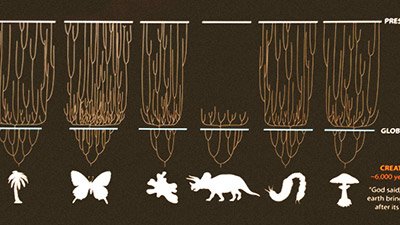
A Trio of Speciation Reminders
A Trio of Speciation Reminders The news this week presented three interesting stories that reinforce the creationist understanding of created kinds, speciation, and “evolution.”
Toronto Star: “Meet the Coywolf”
Perhaps you’ve heard of zonkeys, zorses (a.k.a. zebrulas), ligers, wholphins, and other hybrid animals—but what about the coywolf? As can be guessed from its name, the coywolf is a hybrid between a coyote and a wolf, and they’re becoming more common in Ontario.
According to Trent University geneticist Bradley White, who has studied the hybrids for 12 years, the coywolf has a dangerous combination of “the wolf characteristics of pack hunting and aggression and the coyote characteristics of lack of fear of human-developed areas.” White believes the coywolf’s origin traces back to the 1920s.
As creationists would expect, geneticist Paul Wilson notes that some coywolves are more coyote-like, whereas others are distinctly more wolf-like. In other words, there is a continuum between wolf and coyote. Creationists can understand this continuum as a microcosm of the original canine created kind, which likely included wolves, coyotes, dingoes, some foxes, and ordinary dogs. Each has since become further separated as genetic information is lost within populations; nonetheless, hybrids remind us of their common origin. Yet many of their common characteristics are unique, reminding us that they did not evolve from a non-canid organism.
Still, White utters an oft-heard phrase in response to the hybridization: “evolution in action.”
Science News: “Rapid Evolution May Be Reshaping Forest Birds’ Wings”
God included a range of genetic information and adaptability in organisms to allow them to live properly in a range of habitats.
A study of multiple bird species in Canada and the United States revealed subtle differences in bird wings that depend on the forestation of birds’ habitat. Researchers already knew that more forested areas were home to more birds with rounder wing tips, improving maneuverability around branches. Less forested areas, on the other hand, house birds with more pointed wing tips, which allows more efficient, sustained flight.
Given this, André Desrochers of Laval University examined changes in bird wing tips across the past century by measuring historical specimens. He then cross-referenced the changes with known patterns of human-caused deforestation and reforestation. Unsurprisingly, birds from areas that had undergone deforestation grew longer and sharper wing tips, while the wing tips of birds in reforested areas became shorter and rounder.
The report notes that “as bird species face new challenges, they respond to the extent they can.” This comports with the creationist view: God included a range of genetic information and adaptability in organisms to allow them to live properly in a range of habitats.
The scientists aren’t certain how significant a role genes play in the wing tip changes. Still, Cornell University ornithologist David Winkler noted, “It’s surprising that there’s so much change so fast,” and Desrochers calls “rapid evolution” the most direct explanation. The speed of the changes indicates how the created kinds could have speciated rapidly after the Flood. Centuries of accumulated changes between some populations from the same created kinds resulted in sexual incompatibility. However, in other kinds (such as canids; see above), populations retain the ability even if interbreeding is uncommon.
ScienceDaily: “Speciation through Genome Duplication More Common in Plant Evolution than Previously Thought”
A new study shows that polyploidy—having an extra set of certain chromosomes—plays a more important role in plant speciation than scientists had thought. Rather than three or four percent, the study indicates that fifteen percent of flowering plants and almost a third of fern species “are directly derived from polyploidy,” explained University of Muenster evolutionary biologist Troy Wood. Polyploidy can lead to reproductive isolation, new morphology, and characteristic traits, so is considered at least a potential mechanism for speciation, as another news article explained.
While polyploidy in vertebrates is usually fatal, for plants polyploidy seems to have a generally neutral effect. Nonetheless, the study is a reminder that genetic mistakes only rarely have beneficial effects, instead usually having no effect or negative effects. And when they do result in beneficial differences, it is only because the genetic mistake “breaks” some mechanism, giving the organism a contextual advantage. Speciation due to genetic mistakes—for better or worse—may explain some small portion of the diversity on the planet. But those genetic mistakes cannot account for the origin of all of earth’s species, as evolutionists suggest.
For more information:
Remember, if you see a news story that might merit some attention, let us know about it! (Note: if the story originates from the Associated Press, Fox News, MSNBC, the New York Times, or another major national media outlet, we will most likely have already heard about it.) And thanks to all of our readers who have submitted great news tips to us.
(Please note that links will take you directly to the source. Answers in Genesis is not responsible for content on the websites to which we refer. For more information, please see our Privacy Policy.)

Answers in Genesis is an apologetics ministry, dedicated to helping Christians defend their faith and proclaim the good news of Jesus Christ.
- Customer Service 800.778.3390
- Available Monday–Friday | 9 AM–5 PM ET
- © 2025 Answers in Genesis

